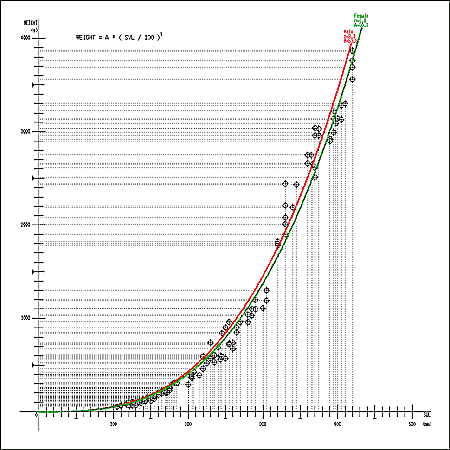[[ SVL-Weight Relation ]]
mNormalized Length-Weight Graphn

Like other reptiles, there are less change in three dimentional ratio of their body size. They grow in a similarity from juvenile to adult. Therefore, there is a prospect of simulating their SVL and Weight relation by a simple cubic function, unless there is a serious density change. From over 70 times research on 13 iguanas, we plotted their data on SVL-Weight coordinate. As expected, plot points seems to fit cubic function. By assumption of simplest function Y = A * X3, we calculated the "A" by using Least Squares Method. Correlative approximation function for SVL-Weight is :
Weight = 51.1 * ( SVL / 100 )3
(Reason for dividing SVL by 100 is to avoid overflow during calculation of "A" and to make "A" to be a easily used number ). The graph drawn by this function matches the plot data very good. Using 51 for "A" is good for approximation. You can simply use your pocket calculator as followings :
First measure your iguana's SVL and put it in your calculator. Divide by 100. multiple the result itself 3 times. Times 51 and you will get the normal Weight. If your iguana weigh more than this result, maybe she is too fat and if she weigh less, she maybe too skinny. Just use this as a index, for sample number is still small and all data is biased to only iguanas those we keep. Use this just as a reference. Please wait for more correct and new revision.
And we did not distinct the sex to get 51.1 for "A". If distinguished, "A" will be :
- Male A = 52.9
- Female A = 50.3